Abstract
1. Naphthalene (1g./kg.) was fed daily by stomach tube to rabbits. 2. In more than half of the rabbits opacities in the lens and degeneration of the retina were visible in vivo. 3. Dissection of eye tissues revealed some or all of the following changes: a browning of the lens and eye humours, blue fluorescence of the eye humours and crystals in the retina and vitreous body. 4. The ascorbic acid concentration of the eye humours was decreased. 5. Some metabolites of naphthalene [1,2-dihydro-1,2-dihydroxynaphthalene, 2-hydroxy-1-naphthyl sulphate and (1,2-dihydro-2-hydroxy-1-naphthyl glucosid)uronic acid] are converted enzymically by the tissues of the eye into 1,2-dihydroxynaphthalene. 6. Changes in the eye are consistent with 1,2-dihydroxynaphthalene's being the primary toxic agent. The properties and reactions of this substance are described. 7. 1,2-Dihydroxynaphthalene is readily autoxidizable in neutral solution to form the yellow 1,2-naphthaquinone and hydrogen peroxide. This oxidation is reversed by ascorbate. 8. Ascorbate is oxidized catalytically by 1,2-naphthaquinone. This may account for the disappearance of ascorbate from the aqueous and vitreous humours of the eye after naphthalene feeding. It may also account for the appearance of crystals of calcium oxalate in the eye. 9. The brown colour of the lens of the naphthalene-fed rabbit is due to presence of naphthaquinone–protein compounds.
Full text
PDF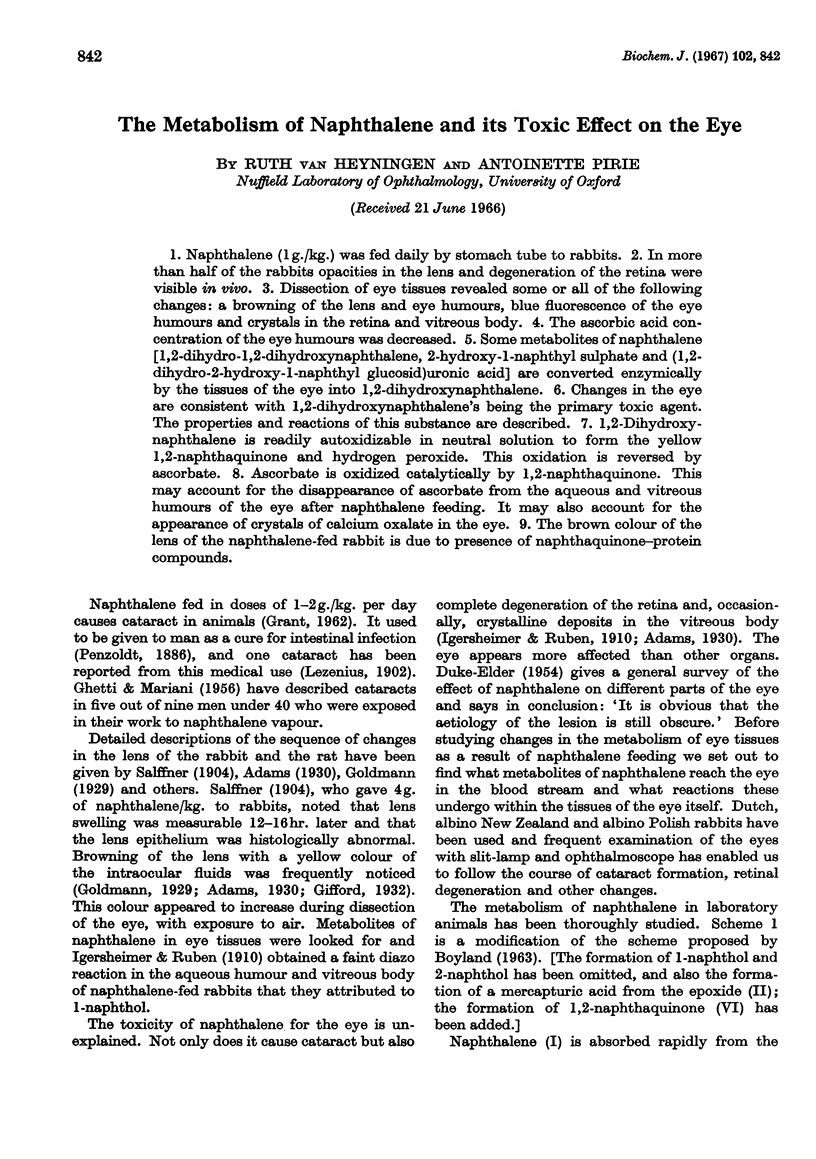
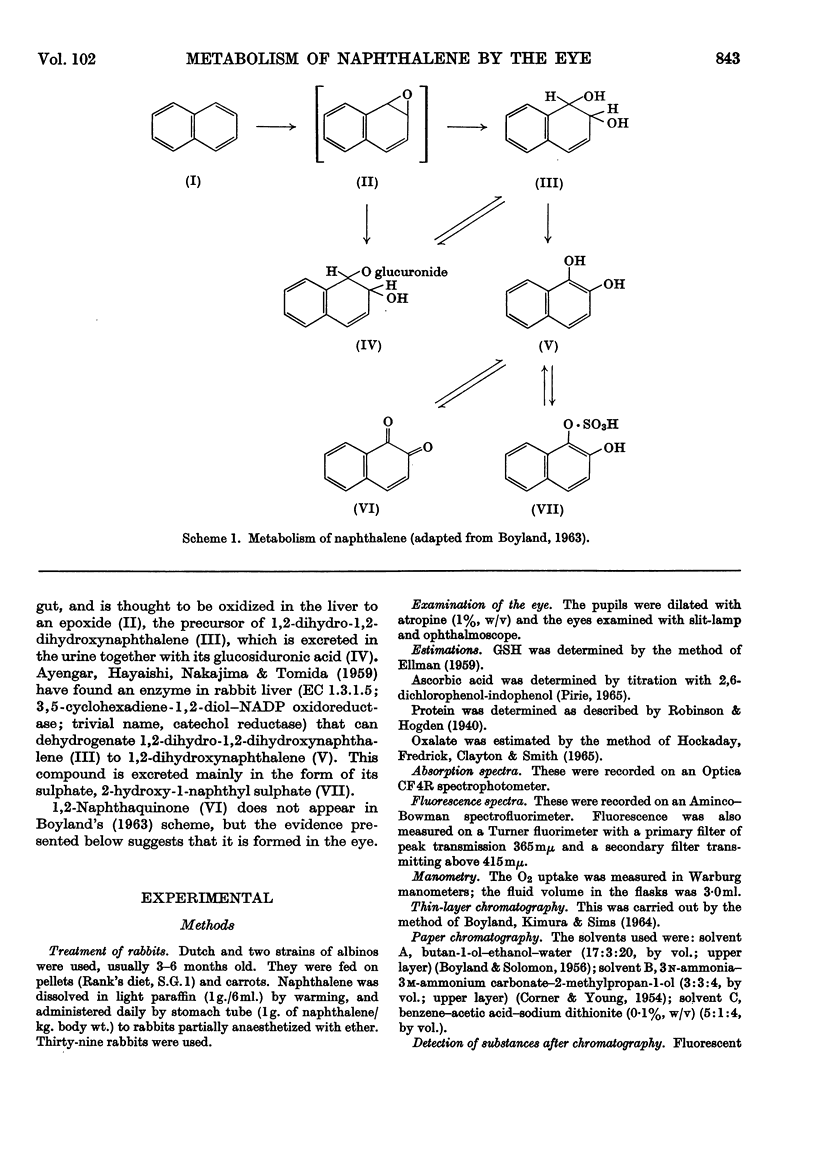
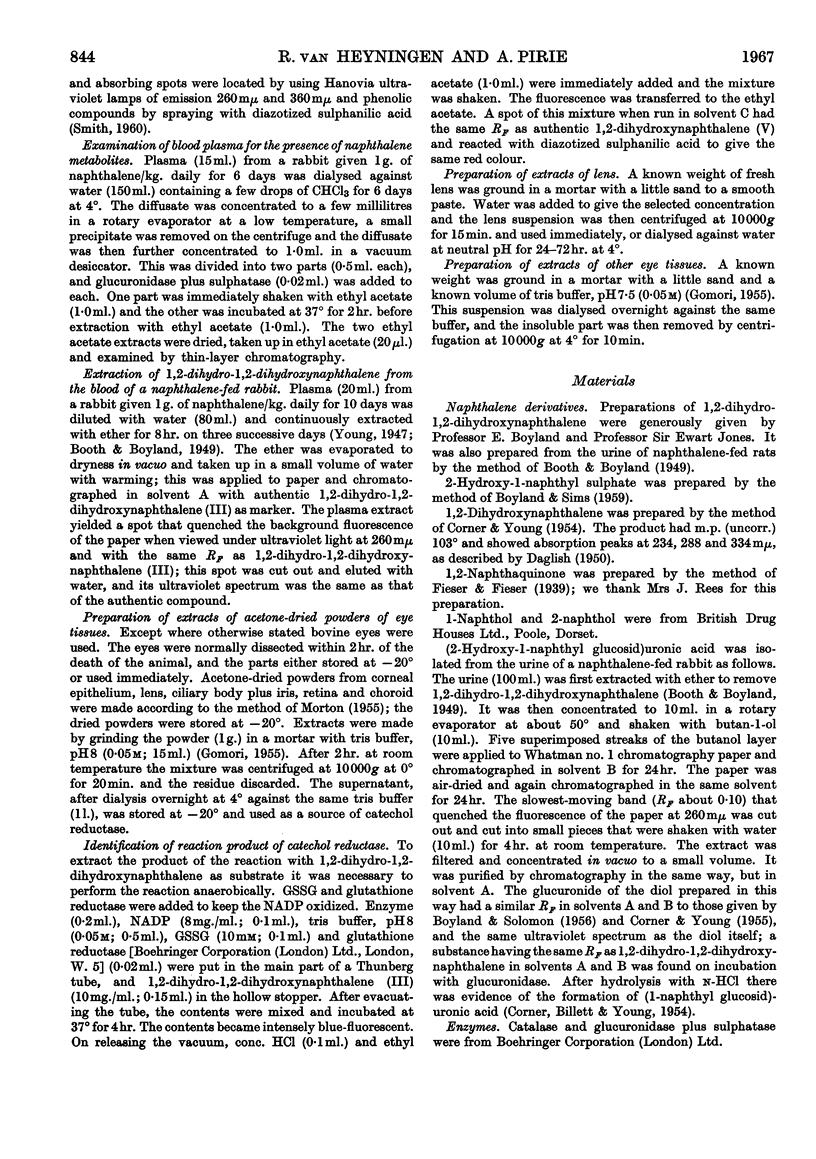
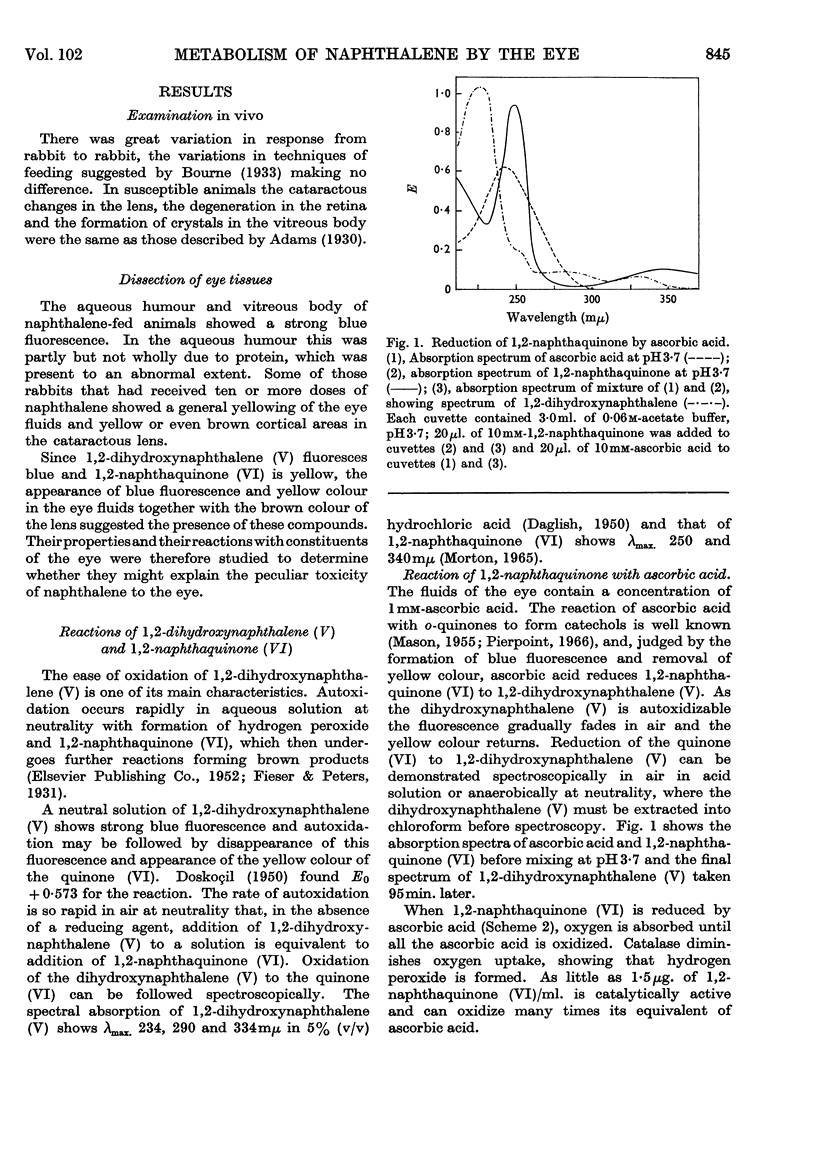
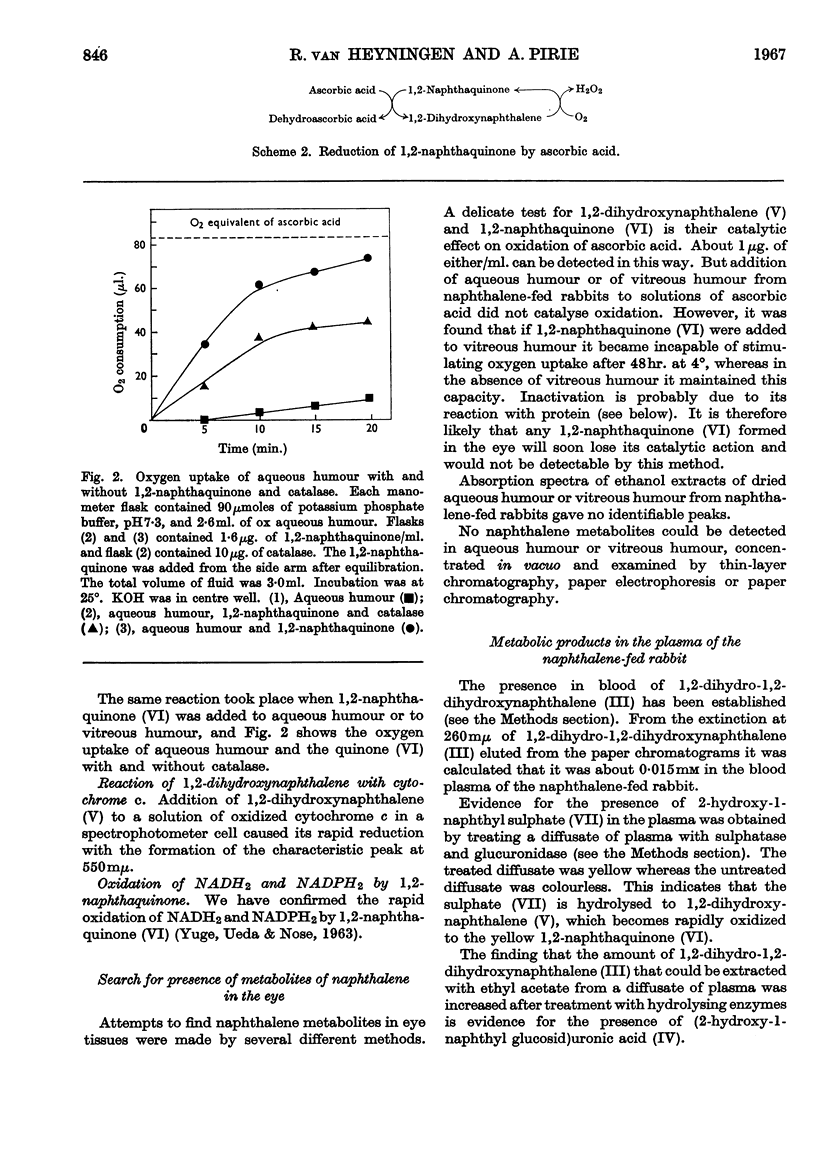
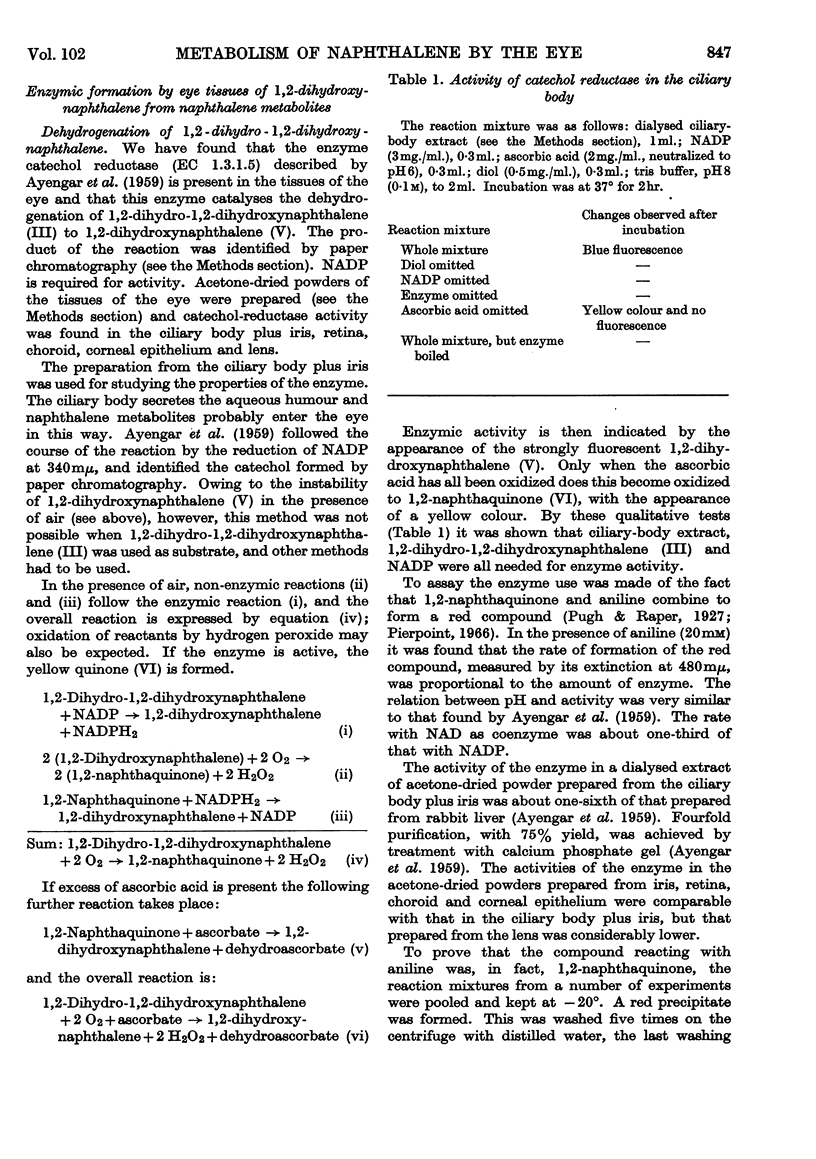



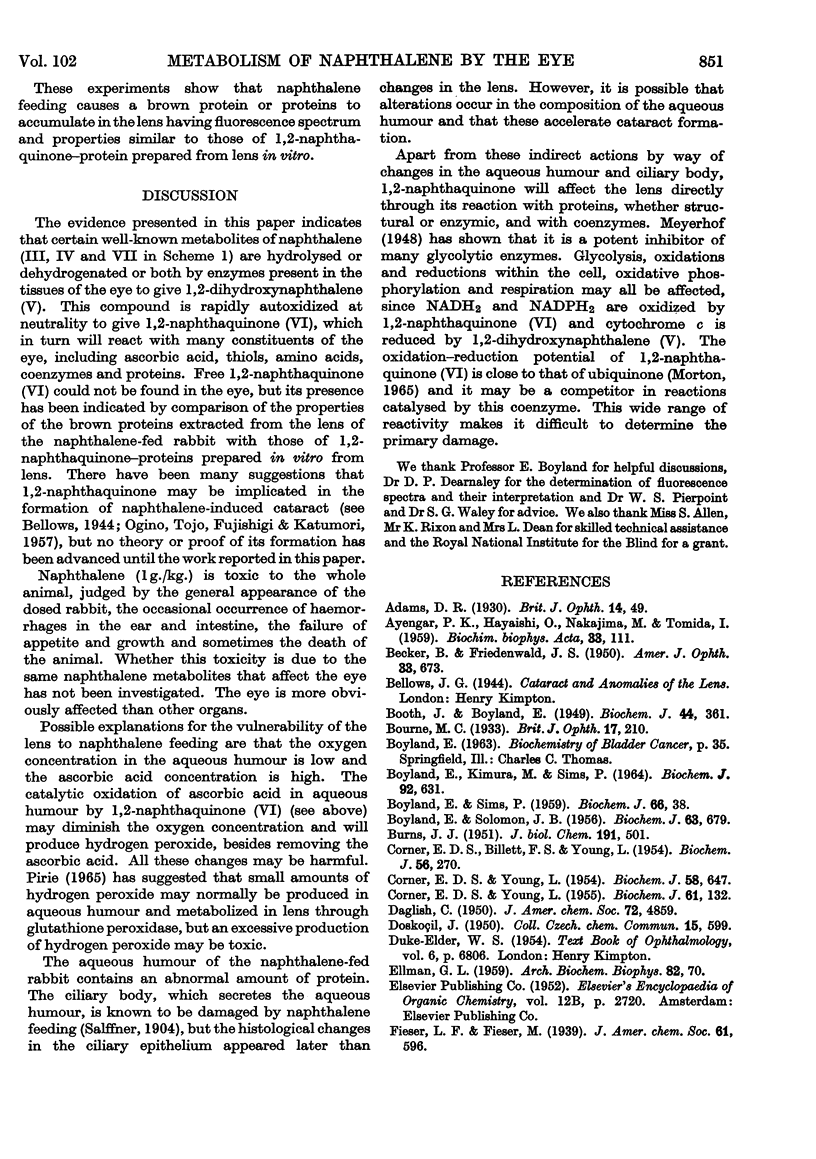
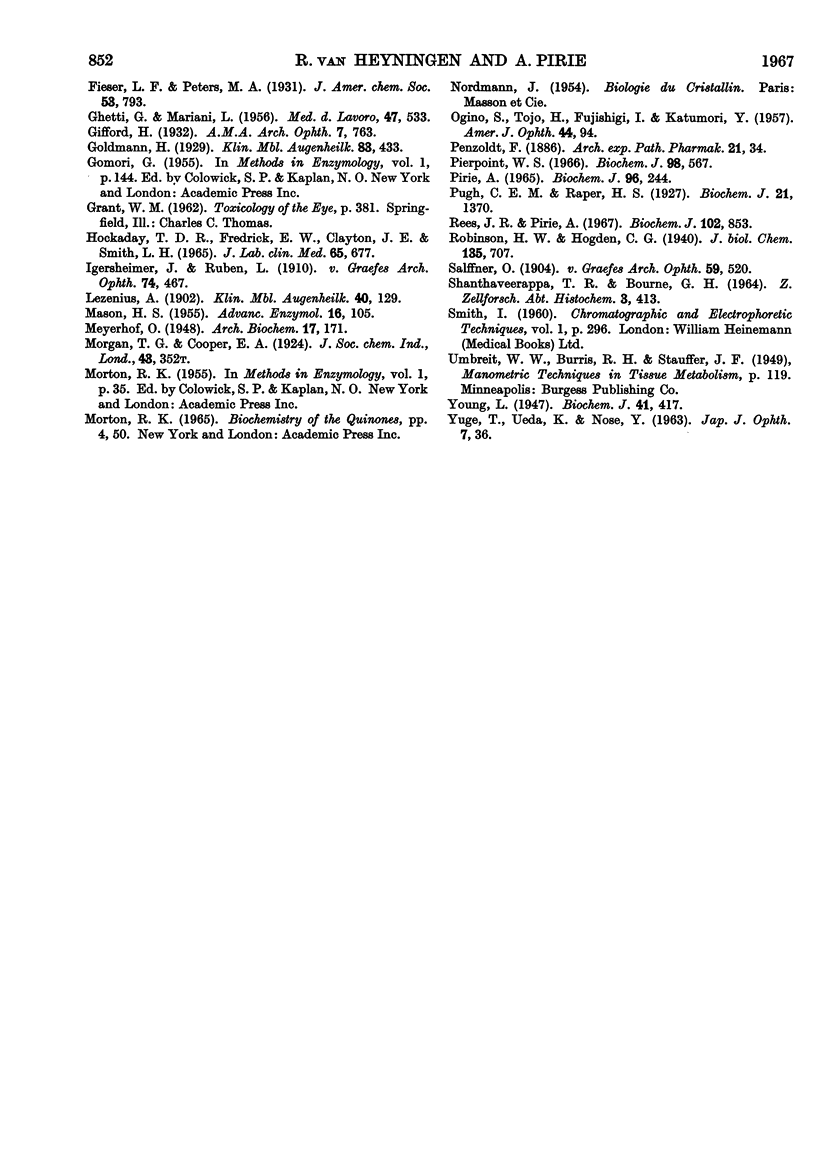
Selected References
These references are in PubMed. This may not be the complete list of references from this article.
- AYENGAR P. K., HAYAISHI O., NAKAJIMA M., TOMIDA I. Enzymic aromatization of 3,5-cyclohexadiene-1,2-diol. Biochim Biophys Acta. 1959 May;33(1):111–119. doi: 10.1016/0006-3002(59)90504-9. [DOI] [PubMed] [Google Scholar]
- Adams D. R. THE NATURE OF THE OCULAR LESIONS PRODUCED EXPERIMENTALLY BY NAPHTHALENE. Br J Ophthalmol. 1930 Feb;14(2):49–60. doi: 10.1136/bjo.14.2.49. [DOI] [PMC free article] [PubMed] [Google Scholar]
- BECKER B., FRIEDENWALD J. S. The histochemical localization of glucoronidase in ocular tissues and salivary glands. Am J Ophthalmol. 1950 May;33(5):673–674. doi: 10.1016/0002-9394(50)90188-7. [DOI] [PubMed] [Google Scholar]
- BOYLAND E., SIMS P. Metabolism of polycylic compounds. XI. The conversion of naphthalene into 2-hydroxy-1-naphthyl sulphate in the rabbit. Biochem J. 1957 May;66(1):38–40. doi: 10.1042/bj0660038. [DOI] [PMC free article] [PubMed] [Google Scholar]
- BOYLAND E., SOLOMON J. B. Metabolism of polycyclic compounds. X. Estimation of metabolites of naphthalene by paper chromatography. Biochem J. 1956 Aug;63(4):679–683. doi: 10.1042/bj0630679. [DOI] [PMC free article] [PubMed] [Google Scholar]
- BURNS J. J., BURCH H. B., KING C. G. The metabolism of 1-C14-L-ascorbic acid in guinea pigs. J Biol Chem. 1951 Aug;191(2):501–514. [PubMed] [Google Scholar]
- Booth J., Boyland E. Metabolism of polycyclic compounds. 5. Formation of 1:2-dihydroxy-1:2-dihydronaphthalenes. Biochem J. 1949;44(3):361–365. [PMC free article] [PubMed] [Google Scholar]
- Bourne M. C. THE EFFECT OF DIET ON THE NATURE OF THE OCULAR LESIONS PRODUCED BY NAPHTHALENE. Br J Ophthalmol. 1933 Apr;17(4):210–220. doi: 10.1136/bjo.17.4.210. [DOI] [PMC free article] [PubMed] [Google Scholar]
- Boyland E., Kumura M., Sims P. Metabolism of polycyclic compounds. 26. The hydroxylation of some aromatic hydrocarbons by the ascorbic acid model hydroxylating system and by rat-liver microsomes. Biochem J. 1964 Sep;92(3):631–638. doi: 10.1042/bj0920631. [DOI] [PMC free article] [PubMed] [Google Scholar]
- CORNER E. D., BILLETT F. S., YOUNG L. Biochemical studies of toxic agents. 6. The conversion of naphthalene into 1:2-dihydro-2-hydroxy-1-naphthyl glucosiduronic acid in the rabbit. Biochem J. 1954 Feb;56(2):270–274. doi: 10.1042/bj0560270. [DOI] [PMC free article] [PubMed] [Google Scholar]
- CORNER E. D., YOUNG L. Biochemical studies of toxic agents. 8. 1:2-Dihydronaphthalene-1:2-diol and its role in the metabolism of naphthalene. Biochem J. 1955 Sep;61(1):132–141. doi: 10.1042/bj0610132. [DOI] [PMC free article] [PubMed] [Google Scholar]
- CORNER E. D., YOUNG L. Biochemical studies of toxic agents. VII. The metabolism of naphthalene in animals of different species. Biochem J. 1954 Dec;58(4):647–655. doi: 10.1042/bj0580647. [DOI] [PMC free article] [PubMed] [Google Scholar]
- ELLMAN G. L. Tissue sulfhydryl groups. Arch Biochem Biophys. 1959 May;82(1):70–77. doi: 10.1016/0003-9861(59)90090-6. [DOI] [PubMed] [Google Scholar]
- GHETTI G., MARIANI L. Alterazioni oculari da naftalina; ricerche cliniche e sperimentali. Med Lav. 1956 Oct;47(10):533–538. [PubMed] [Google Scholar]
- HOCKADAY T. D., FREDERICK E. W., CLAYTON J. E., SMITH L. H., Jr STUDIES ON PRIMARY HYPEROXALURIA. II. URINARY OXALATE, GLYCOLATE, AND GLYOXYLATE MEASUREMENT BY ISOTOPE DILUTION METHODS. J Lab Clin Med. 1965 Apr;65:677–687. [PubMed] [Google Scholar]
- OGINO S., TOJO H., FUJISHIGE I., KATUMORI Y. Biochemical studies on cataract. IX. Contribution to the histopathology of cataract caused by various quinoid substances. Am J Ophthalmol. 1957 Jul;44(1):94–105. [PubMed] [Google Scholar]
- PIRIE A. GLUTATHIONE PEROXIDASE IN LENS AND A SOURCE OF HYDROGEN PEROXIDE IN AQUEOUS HUMOUR. Biochem J. 1965 Jul;96:244–253. doi: 10.1042/bj0960244. [DOI] [PMC free article] [PubMed] [Google Scholar]
- Pierpoint W. S. The enzymic oxidation of chlorogenic acid and some reactions of the quinone produced. Biochem J. 1966 Feb;98(2):567–580. doi: 10.1042/bj0980567. [DOI] [PMC free article] [PubMed] [Google Scholar]
- Pugh C. E., Raper H. S. The Action of Tyrosinase on Phenols: With some Observations on the Classification of Oxidases. Biochem J. 1927;21(6):1370–1383. doi: 10.1042/bj0211370. [DOI] [PMC free article] [PubMed] [Google Scholar]
- Rees J. R., Pirie A. Possible reactions of 1,2-naphthaquinone in the eye. Biochem J. 1967 Mar;102(3):853–863. [PMC free article] [PubMed] [Google Scholar]
- SHANTHAVEERAPPA T. R., BOURNE G. H. HISTOCHEMICAL STUDIES ON THE DISTRIBUTION OF BETA-GLUCURONIDASE IN THE EYE. Z Zellforch Microsk Anat Histochem. 1964 Jan 31;48:413–421. doi: 10.1007/BF00736419. [DOI] [PubMed] [Google Scholar]
- Young L. The metabolic conversion of naphthalene to 1:2-dihydronaphthalene-1:2-diol. Biochem J. 1947;41(3):417–422. doi: 10.1042/bj0410417. [DOI] [PMC free article] [PubMed] [Google Scholar]


